Eggplant Caponata or Aubergine Caponata is one of the golden staples of Sicilian cuisine.
It’s one of the most famous appetizers that is never missing on a Holiday table, being that Christmas, Easter or a Birthday party.
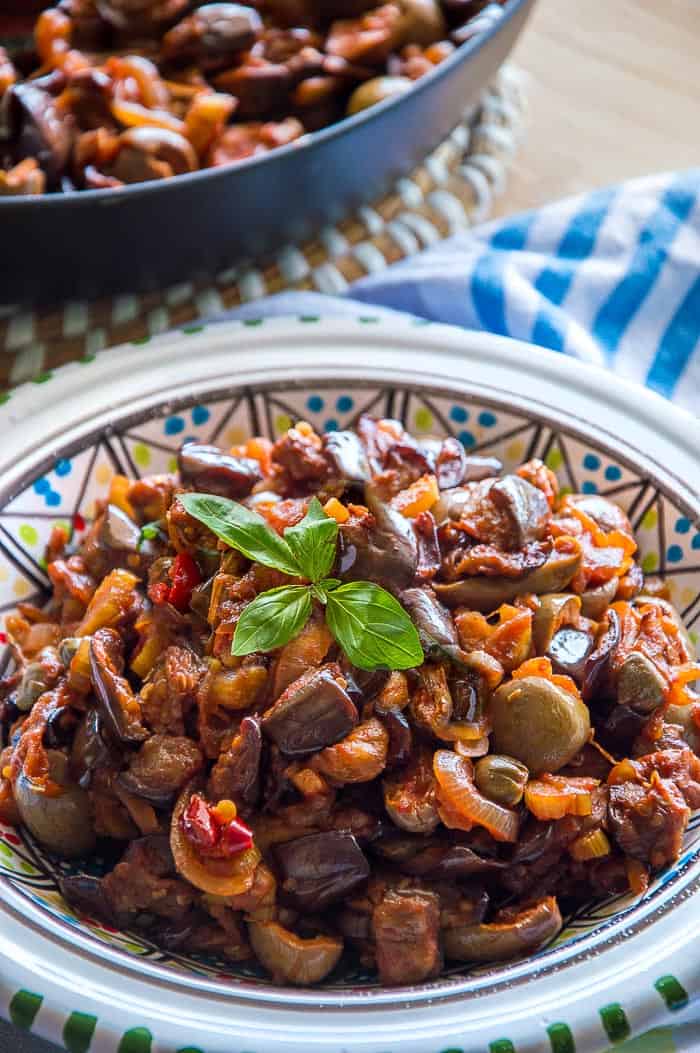
There are different versions of Caponata cooked in Palermo and Caponata from Catania. I’ll tell you all the differences and variations in just moment.
But what remains true and unforgettable is bright summer flavors or eggplants, celery, olives and capers soaked in sweet & sour tomato sauce.
Now served mainly as an appetizer or a side dish it once has been a single dish accompanied only with bread. However you decide to serve it, it’ll be impossible to not reach for another spoon!
Caponata Variations
From Sicily East coast to West Coast there’s a never-ending battle for the most authentic and “correct” versions of Caponata.
The battle between recipe from Palermo and recipe from Catania is worse than one between Capuleti and Montecchi 😀
And with all that, there are still over 30 different Caponata recipes that have been officially documented.
Palermo-Style recipe has less ingredients and mainly because of that I’ve chosen to showcase it in this Caponata version as being the base recipe to add to.
But here’s what you can add to this basic version to make Catania-Style Caponata:
- Sweet bell peppers cut in large cubes (add them at step 2 Preparing Veggies & The Sauce).
- Instead of tomato puree (passata di pomodoro) use fresh tomatoes cut in cubes (also add them at step 2 Preparing Veggies & The Sauce).
- Pine nuts
- Sweet raisins
- Oregano and a bay leaf.
- Potatoes (optional). You won’t always find potatoes in Catania-style eggplant caponata, but ocassionally you’ll come across one that uses potatoes as well. It’s more of a winter-style ingredient and it makes caponata even more creamy.
Trapani-Style Caponata
You may see or not sweet peppers and raisins in Caponata alla Trapanese, but coarsely chopped almonds is an absolute MUST.
Messina-Style Caponata
A lot like a basic Palermo version but the preferance is given to fresh tomatoes cut in cubes rather than tomato puree.
And more!
Sometimes you’ll find carrots, pistachios and even anchovies added to the basic recipe.
So, like there 50 Shades of Grey there are about 50 Shades of Caponata 😀
Which, to me, is pretty awesome. You mix and match and tweak depending on your taste, mood, season of the year, family traditions and what not.
Last word that I want mention about the protagonist of the whole dish.
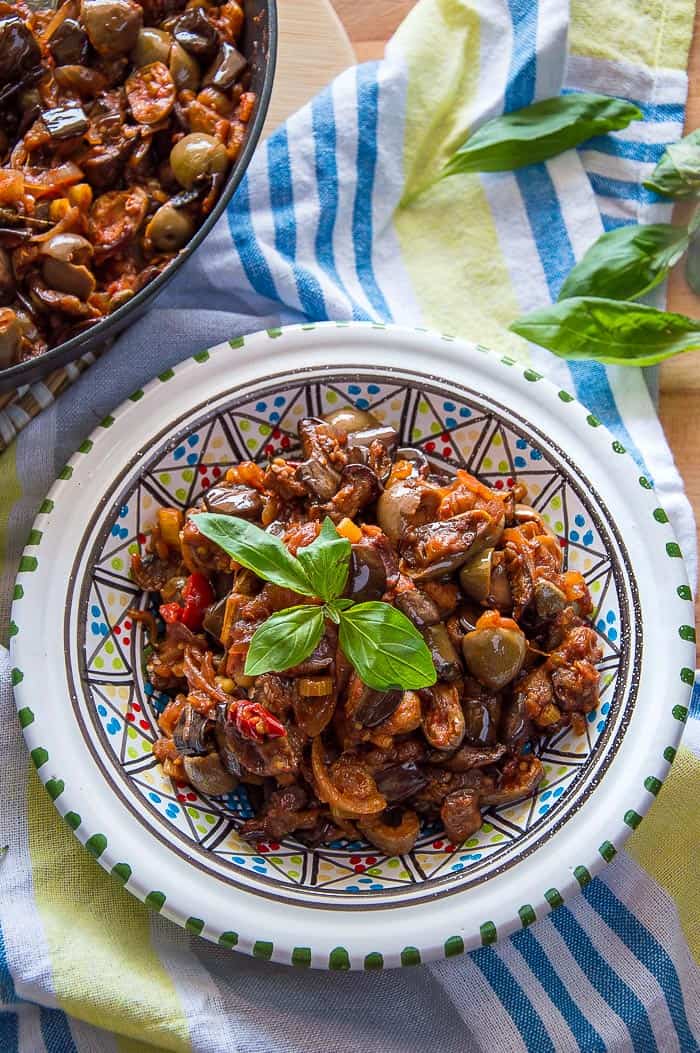
Perfect Eggplants for Caponata
The best eggplants for Caponata are those with dark skin, dense and compact pulp and very few seeds. The last condition is pretty hard to find, as eggplants have fewer seeds only at the beginning of their vegetation season. But don’t let the seeds scare you.
Important part is that you choose a dark skinned aubergine that has a little bit of bitterness in the skin. Unlike for many other recipes it’s perfect to balance sweet & sour flavors of Caponata.
Plus their compact pulp will absorb less oil during frying.
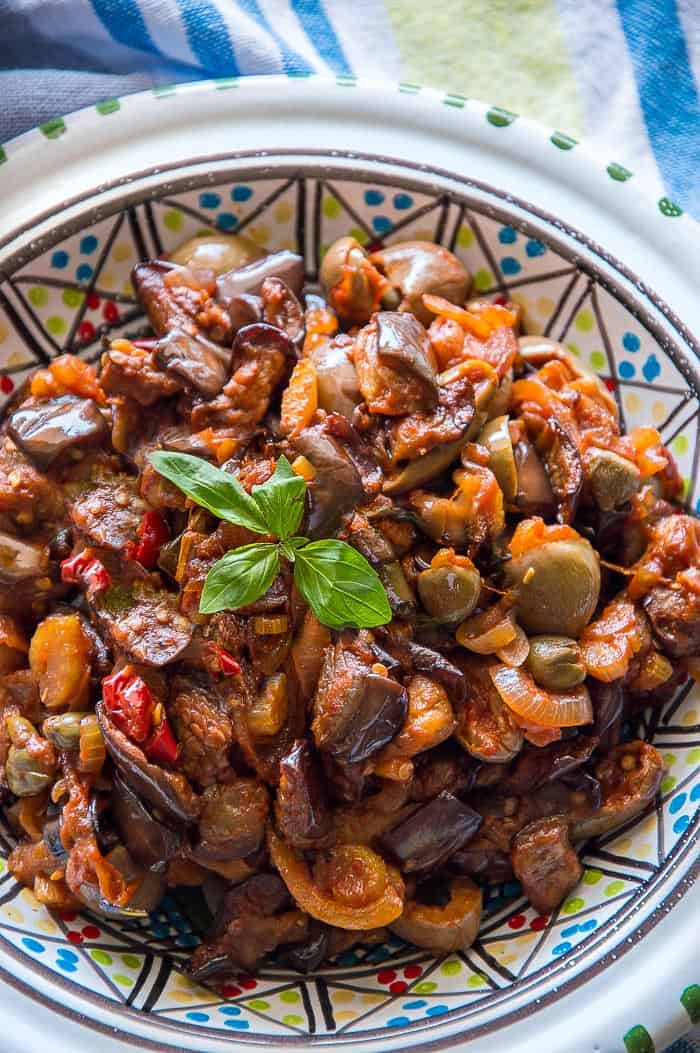
Full Recipe
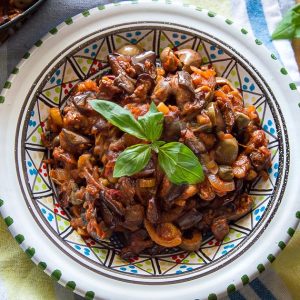
Caponata (Sicilian Eggplant Salad)
Ingredients
- 3 large eggplants , cut in ½ inch cubes
- 1 onion , sliced or chopped
- 3-4 tender celery stalks chopped, approx 1 cup
- 8 oz green olives , pitted and coarsely chopped (approx 1 cup)
- Small piece fresh hot pepper or hot pepper flakes
- 1 cup tomato puree (passata di pomodoro) + some water
- Handful basil leaves
- 3 tablespoon capers
- ¼ cup white wine vinegar
- 3 tablespoon sugar
- Salt to taste
- ⅓ cup Extra virgin olive oil
- Vegetable oil for frying
Instructions
Preparing & Frying Eggplants
- Wash and cut eggplants into large cubes, approx ½ inch. Sprinkle lightly with sea salt, mix and transfer in a colander placed over a deep bowl or over a kitchen sink.
- Let sit for 1-2 hours, until eggplants start to “sweat” - release liquid.
- Using your hands, take eggplants in small batch and squeeze out any additional liquid you can. This step will assure they don’t soak up too much oil during frying.
- Finally, place eggplant cubes between paper towel to get out any remaining liquid.
- Preheat vegetable oil until it’s hot but not “smoking”. Oil temperature should remain around 365 F / 185 C.
- Do a test with a small piece of an eggplant first. It should start sizzling right away when placed in the oil and float atop.
- Fry eggplant cubes until light golden brown, stirring and flipping from time to time.Transfer fried eggplants on a paper towel.Repeat the process with remaining eggplants.Use more paper towel or oil absorbent paper between the layers.
Preparing Veggies And The Sauce
- In a large skillet pan placed on medium-low heat add a generous splash of extra virgin olive oil. Add sliced or diced onions, a small piece of hot pepper and cook for a few minutes.
- Once onions start to soften, add celery stalks cut in cubes, pitted green olives and capers previously cleaned from access salt.
- Also add tomato puree, a few basil leaves (leave more for later) and some water to help all veggies cook nicely in the sauce.
- Cook on low heat for 10-15 minutes until celery is cooked and the sauce thickened.
- Add sugar and white wine vinegar. Stir well.
- Toss in previously fried eggplants, remaining basil leaves and let simmer for another minute or two.
- Taste for salt, add more only if needed.
- Serve warm or cold!
Nutrition
Nutrition information is automatically calculated, so should only be used as an approximation.
Caponata Origin
Know today as a purely vegetarian dish, caponata once was a seafood-based meal.
Called Capone in some parts of Sicily, it's basically a Mahi-Mahi fish which was originally used in this dish instead of eggplants. This fish with fine but somewhat dry pulp was accompanied with sweat & sour vegetable sauce - salsa Agrodolce. And only rich families were able to afford it.
But poor man’s ingenuity had never left them behind.
Pricely fish was successfully subsctituted with cheap eggplants and served with rustic bread.
Fast forward, this is how we know the most classic Caponata recipe today.
Caponata is the best tasted the NEXT day.
But go resist it THAT long 😉


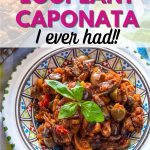
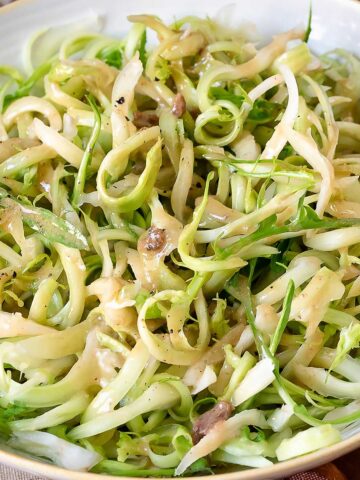
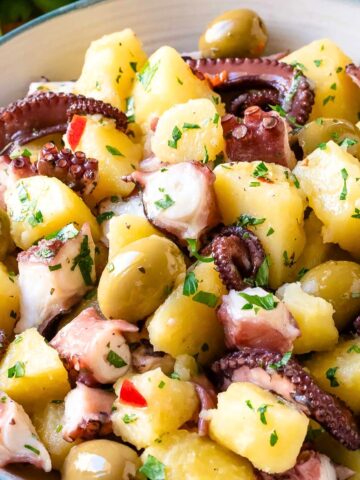

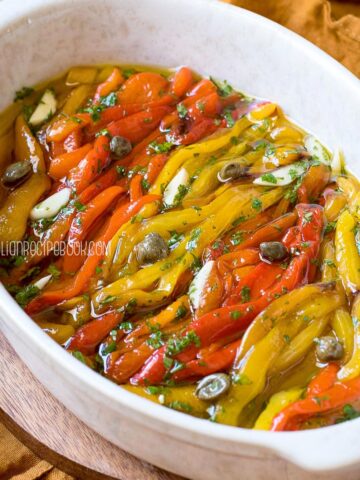
Jan Monteleone says
Delish! My family is from Biancavilla Catania Sicily . This recipe reminds me of my Nonna…. Fantastic with ciabatta . Thank you for this wonderful recipe.
lolly says
Excellent recipe and background info. I'm Sicilian and this is the one.
Phyllis Pascucci says
My mother was from Favignana and this is exactly how she made it. Delicious